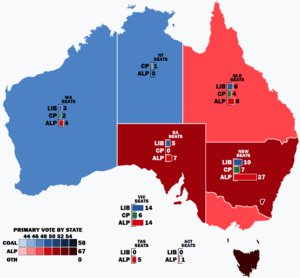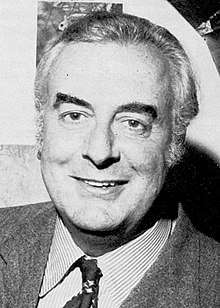1972 Australian federal election
The 1972 Australian federal election was held in Australia on 2 December 1972. All 125 seats in the House of Representatives were up for election, as well as a single Senate seat in Queensland. The incumbent Liberal–Country coalition government, led by Prime Minister William McMahon, was defeated by the opposition Labor Party led by Gough Whitlam. Labor's victory ended 23 years of successive Coalition governments that began in 1949 and started the three-year Whitlam Labor Government.
| |||||||||||||||||||||||||||||||
All 125 seats of the House of Representatives 63 seats were needed for a majority | |||||||||||||||||||||||||||||||
|---|---|---|---|---|---|---|---|---|---|---|---|---|---|---|---|---|---|---|---|---|---|---|---|---|---|---|---|---|---|---|---|
| |||||||||||||||||||||||||||||||
 Popular vote by state and territory with graphs indicating the number of seats won. As this is an IRV election, seat totals are not determined by popular vote by state or territory but instead via results in each electorate. | |||||||||||||||||||||||||||||||
| |||||||||||||||||||||||||||||||
Issues
The 1972 election campaign dealt with a combination of Vietnam and domestic policy issues, and the role of the federal government in resolving these issues. The Coalition of the Liberal and Country parties had been in government for 23 years. Successive Coalition governments promoted conservative economics, trade, and defence. However, Australian economic prosperity during the post-war period of the 1950s and 1960s led to the emergence of a range of "quality of life" issues regarding urban development, education, and healthcare. By 1972 these "quality of life" issues came to represent a major political problem for the coalition parties. Traditionally all of these areas had been handled by the state governments, and the Coalition had always asserted the importance of states rights, a view backed by Liberal state premiers like Robert Askin and Henry Bolte. Between 1966 and 1972, Labor leader Gough Whitlam developed policies designed to deal with the problems of urban and regional development using the financial powers granted to the federal government under the Australian Constitution. As Whitlam put it, Labor focused on "cities, schools and hospitals", and these issues were electorally appealing especially to the young and growing baby boomer generation living in the outer suburbs of the major cities.
By contrast, Coalition policies of conservative economic management, increasing trade, and Australian involvement in the Vietnam War disengaged a significant number of Australian voters. Australian involvement in the Vietnam War was initially popular. However, protests grew as the consequences of the war became apparent and the likelihood of a US-led victory diminished. A major part of the protests were directed at conscripting Australians to fight in the war. Liberal policies on Vietnam focused on the need to contain the spread of communism, but the gradual US and Australian troop withdrawal undermined this position. In 1971, Opposition Leader Gough Whitlam visited China. The Coalition heavily criticised the visit. The criticism soon became an embarrassment when US President Richard Nixon announced he would visit China the following year.

Finally, the incumbent Prime Minister William McMahon was no match for Whitlam, a witty and powerful orator. McMahon's position was precarious to begin with, for he had only emerged as Liberal Leader after a prolonged period of turmoil following the Coalition's unexpectedly poor showing at the half-Senate election held in 1970, and various state elections. In early 1971, Country Party leader John McEwen had retired, to be replaced by Doug Anthony. McEwen, who had disliked McMahon, held a virtual veto over the possibility of his becoming Liberal leader, which he had exercised in 1968. Anthony declared that this veto was no longer in operation, clearing the way for a leadership challenge by McMahon against Prime Minister John Gorton. Gorton survived, but only narrowly, and soon called another leadership election, which he lost. This gave the impression of the Coalition being weak and divided, and consumed in internal struggles.
McMahon was further weakened by concerns about inflation and negative press coverage. For example, Rupert Murdoch and his newspaper The Australian supported the ALP. The ALP ran a strong campaign under the famous slogan It's Time – a slogan which, coupled with its progressive policy programme, gave it great momentum within the electorate after 23 years of Conservative rule.[1]
Results
House of Representatives
| Party | Votes | % | Swing | Seats | Change | ||
|---|---|---|---|---|---|---|---|
| Labor | 3,273,549 | 49.59 | +2.64 | 67 | +8 | ||
| Liberal–Country Coalition | 2,737,911 | 41.48 | –1.84 | 58 | –8 | ||
| Liberal | 2,115,085 | 32.04 | –2.73 | 38 | –8 | ||
| Country | 622,826 | 9.44 | +0.88 | 20 | 0 | ||
| Democratic Labor | 346,415 | 5.25 | –0.77 | 0 | 0 | ||
| Australia | 159,916 | 2.42 | +1.54 | 0 | 0 | ||
| Defence of Government Schools | 9,703 | 0.15 | +0.15 | 0 | 0 | ||
| Communist | 8,105 | 0.12 | +0.04 | 0 | 0 | ||
| National Socialist | 1,161 | 0.02 | +0.02 | 0 | 0 | ||
| Socialist | 1,062 | 0.02 | +0.02 | 0 | 0 | ||
| Independents | 63,228 | 0.96 | –1.57 | 0 | 0 | ||
| Total | 6,601,050 | 125 | |||||
| Two-party-preferred (estimated) | |||||||
| Labor | WIN | 52.70 | +2.50 | 67 | +8 | ||
| Liberal–Country coalition | 47.30 | −2.50 | 58 | −8 | |||
Senate
A special Senate election was held in Queensland to replace Liberal senator Annabelle Rankin, who resigned in 1971.[2] Neville Bonner, who had been appointed to fill the casual vacancy by the Queensland Parliament, won the Senate position – the first Indigenous Australian elected to parliament. The election was held at the time of the House of Representatives elections as per Section 15 of the Constitution.
Otherwise, no Senate election was held. As of 2020, this is the last Australian federal election that did not have a concurrent half or full Senate election.
Seats changing hands
| Seat | Pre-1972 | Swing | Post-1972 | ||||||
|---|---|---|---|---|---|---|---|---|---|
| Party | Member | Margin | Margin | Member | Party | ||||
| Bendigo, Vic | Labor | David Kennedy | 3.0 | 3.2 | 0.2 | John Bourchier | Liberal | ||
| Casey, Vic | Liberal | Peter Howson | 5.0 | 7.2 | 2.2 | Race Mathews | Labor | ||
| Cook, NSW | Liberal | Don Dobie | 2.8 | 3.5 | 0.7 | Ray Thorburn | Labor | ||
| Darling Downs, Qld | Liberal | Reginald Swartz | N/A | 3.4 | 11.3 | Tom McVeigh | Country | ||
| Denison, Tas | Liberal | Robert Solomon | 2.6 | 7.2 | 4.6 | John Coates | Labor | ||
| Diamond Valley, Vic | Liberal | Neil Brown | 6.1 | 7.7 | 1.6 | David McKenzie | Labor | ||
| Evans, NSW | Liberal | Malcolm Mackay | 1.2 | 3.9 | 2.7 | Allan Mulder | Labor | ||
| Forrest, WA | Labor | Frank Kirwan | 1.1 | 4.7 | 3.6 | Peter Drummond | Liberal | ||
| Holt, Vic | Liberal | Len Reid | 3.5 | 7.9 | 4.4 | Max Oldmeadow | Labor | ||
| Hume, NSW | Country | Ian Pettitt | 1.0 | 2.9 | 1.9 | Frank Olley | Labor | ||
| La Trobe, Vic | Liberal | John Jess | 5.2 | 10.2 | 5.0 | Tony Lamb | Labor | ||
| Lilley, Qld | Liberal | Kevin Cairns | 1.7 | 1.7 | 0.0 | Frank Doyle | Labor | ||
| Macarthur, NSW | Liberal | Jeff Bate† | 3.8 | 6.0 | 2.2 | John Kerin | Labor | ||
| McMillan, Vic | Liberal | Alex Buchanan† | N/A | 2.9 | 2.4 | Arthur Hewson | Country | ||
| McPherson, Qld | Country | Charles Barnes | N/A | 6.5 | 4.7 | Eric Robinson | Liberal | ||
| Mitchell, NSW | Liberal | Les Irwin | 2.5 | 3.7 | 1.2 | Alfred Ashley-Brown | Labor | ||
| Phillip, NSW | Liberal | William Aston | 0.4 | 4.1 | 3.7 | Joe Riordan | Labor | ||
| Stirling, WA | Labor | Harry Webb | 5.5 | 8.4 | 2.9 | Ian Viner | Liberal | ||
| Sturt, SA | Labor | Norm Foster | 0.5 | 2.2 | 2.7 | Ian Wilson | Liberal | ||
- †Jeff Bate and Alex Buchanan contested their seats as independent candidates.
Significance
The 1972 election ended 23 years of Liberal-Country rule—the longest unbroken run in government in Australian history. It is also unusual as Whitlam only scraped into office with a thin majority of 9 seats. Typically, elections that produce a change of government in Australia take the form of landslides (as in the elections of 1949, 1975, 1983, 1996, 2007 or 2013, for example). The comparatively small size of Whitlam's win is partly explained by his strong performance at the previous election of 1969, where he achieved a 7 percent swing, gaining 18 seats, from a low of 41 of 124 seats and a 43 percent two-party figure at the 1966 election.
The new Labor Government of Gough Whitlam was eager to make long-planned reforms, although it struggled against a lack of experience in its cabinet and the onset of the 1973 oil crisis and 1973–75 recession. In addition, the Senate was hostile to Whitlam, with the Coalition and Democratic Labor Parties holding more seats than the ALP, as the term of the Senate at the time was 1971 to 1974. This in particular would make governing difficult and led to the early double dissolution election of 1974.
See also
- Candidates of the Australian federal election, 1972
- Members of the Australian House of Representatives, 1972-1974
Notes
- Wendy Lewis, Simon Balderstone and John Bowan (2006). Events That Shaped Australia. New Holland. pp. 234–238. ISBN 978-1-74110-492-9.
- "Glossary of Election Terms – Federal Election 2007". ABC. Retrieved 30 July 2016.
References
- AustralianPolitics.com 1972 election details
- "It's Time For Leadership" – Whitlam policy speech, 13 November 1972
- University of WA election results in Australia since 1890
- AEC 2PP vote
- Prior to 1984, the AEC did not undertake a full distribution of preferences for statistical purposes. The stored ballot papers for the 1983 election were put through this process prior to their destruction. Therefore, the figures from 1983 onwards show the actual result based on full distribution of preferences.

.jpg)
